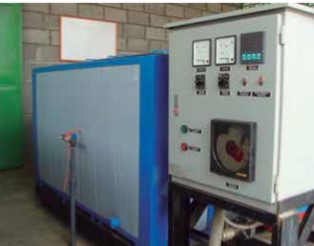Hydrothermotherapy: technique for the management of some systemic diseases in sugar cane
Abstract
Sugarcane, like any other crop, is affected by a series of diseases caused by fungi, viruses and bacteria, which are undoubtedly one of the main biotic factors in the decrease in production and duration of exploitation of a plant. plantation. Currently, there are commercial varieties of sugarcane of economic importance in the country's sugar production that are susceptible to certain diseases such as: charcoal, chlorotic streak, mosaic, bacilliform virus, soca rickets, scald, among others. For this reason it is necessary to keep them in production with the support of an adequate phytosanitary management, until other healthy varieties are released.
Sugarcane, like any other crop, is affected by a series of diseases caused by fungi, viruses and bacteria, which are undoubtedly one of the main biotic factors in the decrease in production and duration of exploitation of a plant. plantation. Currently, there are commercial varieties of sugarcane of economic importance in the country's sugar production that are susceptible to certain diseases such as: charcoal, chlorotic streak, mosaic, bacilliform virus, soca rickets, scald, among others. For this reason it is necessary to keep them in production with the support of an adequate phytosanitary management, until other healthy varieties are released.
Among the management practices to combat phytosanitary problems are: use of resistant varieties, eradication of strains, planting varieties in their time, elimination of natural host plants, vector control, disinfection of seed cutting utensils, applications of agrochemicals, seed sanitation by in vitro micro-propagation (stem tips), and heat treatment of asexual seed (cuttings), among others.
The high quality of the seed is given by the components: genetic (varietal purity), physical (general appearance of the plantation), physiological (good sprouting, vigor and age) and sanitary (absence of diseases transmitted by seed). The conjunction of these components in the seed allows to obtain a high production, ensuring economic profitability over time as a response to the investment made.
When it is not possible to effect seed sanitation by micropropagation, the component can be improved in future seedbeds, using heat treatment of the seed as an alternative. Among the types of heat therapy that can eliminate pathogens in sugarcane varieties, we can mention hot air, aerated steam and hydrothermotherapy (hot water) using different temperatures and exposure times. This work will deal with the hydrothermotherapy technique in the management of some systemic diseases in sugar cane.
Among the management practices to combat phytosanitary problems are: use of resistant varieties, eradication of strains, planting varieties in their time, elimination of natural host plants, vector control, disinfection of seed cutting utensils, applications of agrochemicals, seed sanitation by in vitro micro-propagation (stem tips), and heat treatment of asexual seed (cuttings), among others.
References
Digonzelli, P., J. Giardina, J. Fernández, S. Casen M. Tonatto, M. Leggio, E. Romero y L. Alonso. 2009. Caña semilla de alta calidad: obtención y manejo. Capítulo 4. Manual del cañero. Estación Experimental Agroindustrial Obispo Colombres. Tucumán, Argentina. 49-64 pp.
FUNDAZUCAR (Fundación Azucarera para la Investigación y la Productividad). 1993. Principales enfermedades, deficiencias de nutrientes, daños por herbicidas, salinidad y mal drenaje. Manual ilustrado de caña de azúcar No.1. Barquisimeto, Edo. Lara. 63 p.
Nass, H., A. Chinea, C. Daboin, y M. Diez. 2000. Enfermedades y daños de la caña de azúcar en latinoamérica. Barquisimeto, Edo. Lara. 108 p.
Moraila, L. 2012. Se buscan mejores plántulas de caña para trasplante o replanteo, Técnica de hidrotermoterapia. Proyecto del Centro de validación y trasferencia de tecnología de Sinaloa, México. Disponible en: http://www.cofupro.org.mx/cofupro/cofupro_web. php?idseccion=844. Consultado: 19/08/2015.


